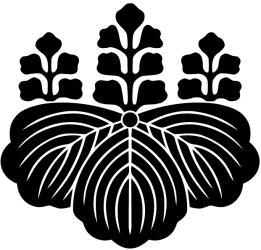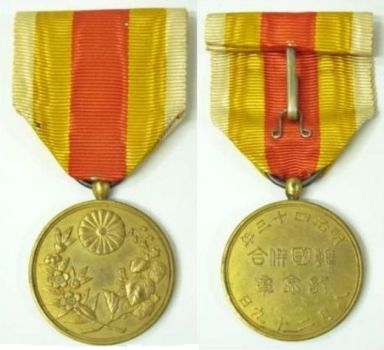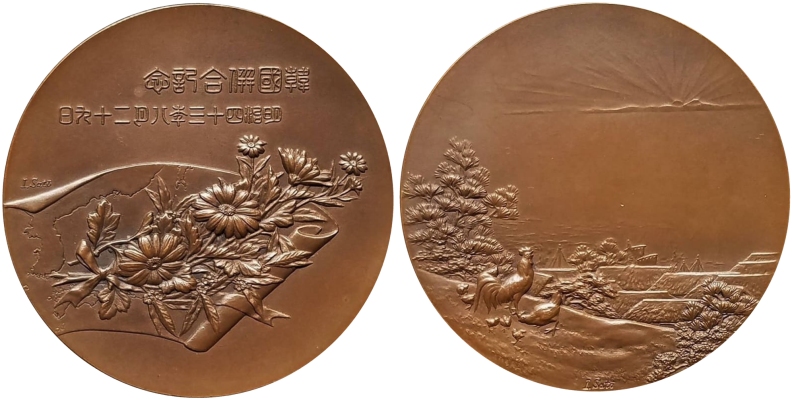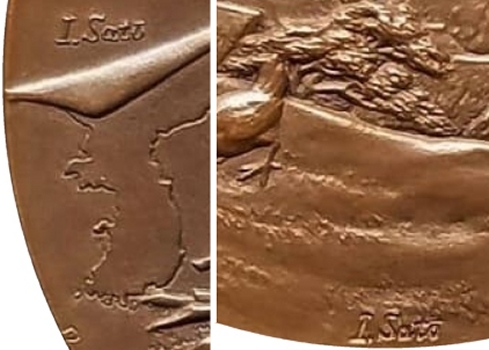
1911-1919
From an historical perspective, Japan succeeded in opening Korea with the unequal 1876 Japan–Korea Treaty of Amity 日朝修好条規, known in Korea as the Ganghwa Island Treaty 江華島條約 (강화도 조약). After which, Japan embarked on a decades-long process to gain full control of the peninsula. After Japan defeated China in the 1894–1895 First Sino–Japanese War 淸日戰爭 (청일전쟁), Korea became nominally independent and declared itself to be the Korean Empire 大韓帝國 (대한제국). Japan then defeated Russia in the 1904–1905 Russo-Japanese War 日露戦争 (일로전쟁), making Japan the sole regional power. It then moved quickly, and Korea became a protectorate under the Japan–Korea Treaty of 1905 (known in Korea as the Eulsa Treaty 乙巳條約 (을사조약 ), under which Japan ruled the country indirectly through the Japanese Resident-General of Korea 朝鮮統監 (조선통감).1 The treaty deprived Korea of its diplomatic sovereignty. In 1907, it forced the Korean Emperor Kojong to abdicate in 1907. Japan formally annexed Korea with the Japan–Korea Treaty of (August 29) 1910 韓日倂合條約 (한일병합조약). This officially started the Japanese colonial period in Korea. The treaty had eight articles, the first being: “His Majesty the Emperor of Korea makes the complete and permanent cession to His Majesty the Emperor of Japan of all rights of sovereignty over the whole of Korea”. Koreans, when referring to the Annexation Treaty of 1910, often use the term 경술국치 庚戌國恥 “National Humiliation of the Year of Gyeongsul”2 or 국치일 國恥日 “National Humiliation Day”. Another term used by Koreans is 강제조약, “The Coerced Treaty”. On August 29, 1910 (Meiji 43), Japan promulgated and enacted Imperial Decree No. 318, entitled “Rename Korea to Chosŏn” (韓国ノ国号ヲ改メ朝鮮ト称スルノ件). By this, the Japanese official name for the Korean peninsula and its annexed islands was ‘restored’ to ‘Chosŏn (朝鮮)’. The first Chosŏn refers to the kingdoms that existed in Manchuria and on the Korean peninsula until 108 BC. The second Chosŏn was Chosŏn Dynasty, founded in 1392, but was changed in 1897 to the Great Han Empire 大韓帝國. In addition to the name change, through Residency-General’s Ordinance No. 5 메이지 43년 제령 제5호, the office of ‘Residence-General’ was changed to ‘Governor-General of Chosŏn’. With the Annexation of Korea, the Great Korean Empire 大韓帝國, ceased to exist. During the colonial period, some independence activists refused to use the name ‘Chosŏn’ because it was used by the Japanese colonial authorities. Many activists changed the ‘Empire’ of the Korean Empire to ‘Min Guk’ 민국, an old word for the Republic. The peninsula was then administered by the Governor-General of Chosŏn 朝鮮総督 (조선총독), based in Keijō 京城, (Korean Gyeongseong 경성 Literally Capital City, present day Seoul), until the end of the colonial period.3 Japanese colonial rule over Korea is generally divided into three separate periods. The Military Rule Period 武斷統治 (무단통치), also known as the Reign of Terror 공포정치, lasted from 1910 to 1919 and is most obviously demonstrated by school teachers wearing swords in the classroom. Peaceful Demonstrations beginning on March 1, 1919, forced Japan to reconsider its administration. The Cultural Rule Period 文化統治 (文화통치) lasted from 1919 to 1931. In this period, Japan allowed more freedoms, including freedom of the (Korean) press. The National Annihilation Rule Period 民族抹殺統治 (민족말살통치) lasted from 1931 to 1945. It is also known by the slogan 内鮮一体 (내선일분) “Naeje (Japan) and Chosŏn (鮮) are one body”. This period was dominated by the attempted genocide of Korean culture. The Korean language was not allowed to be taught in schools, Korean were forced to take Japanese names and hundreds of thousands of Koreans were forced to serve the Japanese war effort. While Korea’s economy grew under Japan, most scholars argue that the vast majority of the infrastructure projects were designed to extract resources from the peninsula, and not done for the sake of the Korean people. (Side note: Korean rice was heavily transported to Japan, and Koreans were forced to add barley to their diet, which is still manifested in the Korean diet today.)
The Annexation Medal

In 1910, Japan officially absorbed Korea into the Japanese Empire, but the Korean Annexation Commemorative Medal 韓國併合記念章 wasn’t issued until 1912.
A proposal to issue a medal commemorating the event was approved by the Prime Minister and on Feb. 9, 1912, it was passed to the cabinet for study. On Mar. 5th, it got an approval from the Legislation Bureau and on March 28, 1912, the medal was created when the Emperor Meiji issued Edict 56, just 4 months before his death July 30, 1912.
Those who were to receive this medal were described in article 3 of the Edict as 1) those that were directly involved in the project to annex Korea and those who engaged in activities initiated in support of the annexation, 2) Officials and equivalent personnel stationed in Korea at the time of the annexation, and Korean officials and equivalent personnel within the Korean government at the time of annexation, and 3) Those who had previously contributed to Japan-Korea relations. This edict also mentioned for the first time that the medal could be presented to a bereaved family in cases where the intended recipient had passed away before the awarding. Posthumous award criteria is not found in earlier commemorative medal edicts.
The medal’s obverse has two flowering tree branches crossed under the chrysanthemum crest, with the right side branch being from a paulownia tree, representing Japan and the left side branch being from a plum tree, representing Korea. 4
The medal reverse has the year on top as 明治四十三年 “43rd Year of Meiji” (1910). There are two lines across the center which read as 韓國併合 “Korea Annexation” and 記念章 “Commemorative Medal”. The remaining part of the date is at the bottom 八月二十九日 “August 29th”. The planchet is in brass/bronze and 30 mm in size.5 There are no versions manufactured in gold or silver. The ribbon is 36 mm watered silk, with 4 mm white edge stripes, 9 mm yellow stripes and a 12 mm vermilion center stripe. 6 Article 2 of the Imperial Edict said that the medal was to be worn on the left side of the chest. There are some discrepancies regarding the total number of medals issued, but the award documents have serial numbers up into the 37,400 range. The award documents were not issued until May 3, 1913, but all of them carry the award date of Aug. 1, 1912. There is no mention of a medal specifically designed for women. The master mold for this medal is attributed to 佐藤磐 Ban Sato, who also designed the mold for the reverse side of the 1915 Taisho Enthronement Medal. The cases were light paulownia sandalwood, which was a departure from the lacquered cases used for the previous 3 war commemorative medals.

The Inscription on the obverse is 韓國併合記念 “Korean Annexation Commemorative” (한국 합병 기념관), and the date 明治四十三年八月二十九日 “43rd Year of Meiji, 8th month 29th day (Aug. 29, 1910)”.
The reverse is said to symbolize that a new day is coming to Korea.

Chinilpa 친일파 親日派
To give an idea of how the Koreans view this medal, the five Korean cabinet ministers who agreed to make Korea a protectorate in 1905, the seven cabinet ministers who signed away Korean sovereignty to Japan in 1907 and the nine Koreans involved in the Annexation Treaty of 1910, are all referred to as Chinilpa, which in today’s connotation means “National Traitor”. Another term that is often used is 매국노 Maekukno, “Betrayer”. In 2005, one hundred years after the signing of the Protectorate Treaty, the South Korean government created the “Special Law to Redeem Pro-Japanese Collaborators’ Property”. Any assets confiscated from the descendants of Chinilpa are used to compensate pro-independence activists and their offspring. In 2010, a commission concluded its five-volume report, by which the real property of 168 South Korean citizens has been confiscated by the government, these citizens being direct descendants of pro-Japanese collaborators.
Not everyone, who was eligible to receive this medal, actually took possession. There are documented cases where eligible recipients refused to accept. Some eligible recipients, rather than support the Japanese, either quit, retired, or went into self-imposed exile in another country. On August 29, the date that the Annexation was announced, public gatherings were prohibited, and the newspapers were closed down. There were several people who committed suicide to express their resentment, but their bereaved families were threatened by the police, not to reveal what had transpired. Even earlier, when Korea was placed as a protectorate of Japan, there were Koreans who committed suicide. Min Young-hwan 민영환 閔泳煥 is probably the highest member of the Korean Royal Family to commit suicide, rather than live under the Japanese.
Footnotes:
- Eulsa refers to the sexagenary calendar system of China. Here the term Eulsa specifically references 1905, but Eulsa also corresponds to other years such as 1965, 2025, 2085, etc. which are 60 years apart. It was used throughout the East Asian cultural sphere.
- Gyeongsul is another sexangenary calendar reference. Here it refers to 1910. It can refer to 1850, 1910, 1970, 2030, etc.
- If you try to translate 京城 you will get Beijing (Peking, China), which is also a Capital City
- The Korean Royal Family was named Yi (Lee) and is written in Chinese as 李 which means “Plum” or “Plum Tree”. It is one of the most common surnames in Asia.
- There are websites which state that it was also issued in silver, but I cannot confirm.
- According to the James Peterson monograph “Orders & Medals of Japan and Associated States”, the red and white stripes represent the national colors of Japan while the yellow and white stripes represent the national colors of Korea.
